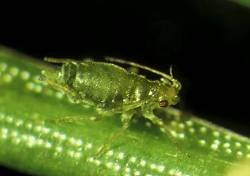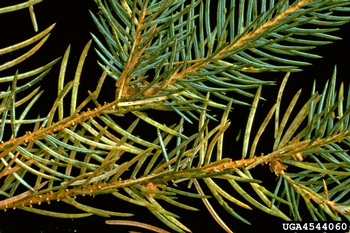Green Spruce Aphid (Elatobium abietinum)
Trees Affected
Common: Spruces, including Sitka Spruce
Occasional*: True Firs, Siberian Larch, Eastern White Pine, Scotch Pine, Douglas Fir
*Only during outbreaks
Summary
The green spruce aphid is a small (1-2mm), green insect with reddish eyes that feeds primarily on the needles of spruce trees. These invasive sap suckers cause marked defoliation, stunted growth, and occasionally, full tree mortality. Although this aphid is present on their host tree throughout the year, they are most active during the late winter and early spring, before most native aphid parasites are present. Infestations are often only detected when the affected needles drop, after the majority of the damage is done. The aphids generally feed on older needles, so one sign of this pest is defoliation of all but the current season’s needles. On younger trees (< 5 years), the aphids primarily feed on the upper canopy, while in older trees they attack shaded areas, which are generally on the lower portion of the tree. Like many aphids, the green spruce aphid produces honeydew, which facilitates the growth of a sooty mold on the host tree. Although the presence of sooty mold is not a definitive sign of green spruce aphid in particular, it is a good indicator of a potential aphid infestation. Shaking affected foliage over a piece of white paper to see if green aphids fall onto it is a common method of detection.
Local Distribution
The local distribution of this insect is unknown, but appears to be widespread. Trees with symptoms consistent to those produced by green spruce aphids have been found along Highway 101 between Fortuna and Orick, as well as along roads throughout coastal Humboldt County.
Management Strategies
Little research has been done on how to manage green spruce aphids in coastal California. Introduction of natural predators of this aphid has not produced a notable decline in their population. Due to the widespread impact of green spruce aphids in this region, the use of insecticides is not recommended, as the impact on the ecosystem is far greater than the success rate of using the insecticide (although this strategy may be appropriate for individual, high value trees). Although healthy trees tend to host a larger population of these aphids, they also sustain less damage than stressed trees. Therefore, reducing stressors and improving tree vigor are still beneficial for managing the effects of this insect even though doing so will not eliminate these aphids entirely. However, some methods of improving tree vigor are likely to be more effective at reducing aphid populations than others. For example, thinning over-crowded stands of spruce reduces competition for water and resources, while also reducing humidity and increasing light availability within the stand, all of which improve tree vigor and make the stand less attractive to aphids. Conversely, the use of certain fertilizers to improve tree vigor may attract a larger infestation, as these aphids (like most aphids), favor needles with higher nitrogen content. Trees in urban areas may also be more vulnerable to aphid attacks due to nitrogen deposition from roadways, so in these areas, reducing additional stress by removing harmful invasive understory plants (particularly English Ivy) may be a helpful management strategy.
Pests and Pathogens with Similar Symptoms
Giant Conifer Aphids (Cinara spp.): Aphids in this genus feed on sap from roots, twigs, and branches of various conifer species. Although they are aphids and share a basic body plan, they are much larger than green spruce aphids (5-6 mm in length) and dark brown or black instead of green. They are also frequently mistaken for ticks, so if your aphid looks like a tick, it’s likely a giant conifer aphid and not a green spruce aphid.
Further Reading
Description with distribution map, aphid biology, and management strategies:
https://www.cabi.org/isc/datasheet/30897#tosymptoms
Description of the aphid. Note that risk and management sections are written for a European setting and may not be accurate to local forests and conditions :


